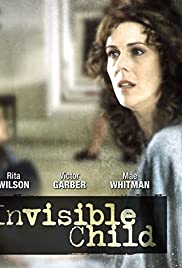
INVISIBLE CHILD
US, 1998, 87 minutes, Colour.
Rita Wilson, Victor Garber, Mae Whitman, Tushka Bergen, David Dorfmann.
Directed by Joan Micklin Silver.
Invisible Child is a telemovie about mental illness. It portrays a loving family, almost the ideal American family, in an affluent society. However, there have been difficulties between the husband and wife in the past, the wife having an imaginary pregnancy and an imaginary child. She has continued for five years living with this invisible child, her husband and her older daughter taking responsibility for her and pretending to support the child. Her young son, aged four, sometimes thinks he sees the child and also participates in the pretence.
When an English nanny arrives, she is able to adapt to the situation but is concerned. She approaches the child welfare authority, who eventually come to the house in a most confronting manner, citing the law for their intrusive behaviour. This brings about a crisis for how the family will deal with the problem. The film ends somewhat easily with a deception of the authorities but also the mother experiencing the death of her child.
Rita Wilson is all smiles and charm as the mother, devoted to her family, especially the invisible child. Victor Garber is strong as the supportive father. Mae Whitman (The Miracle on 34th Street) is also strong as the older daughter. Tushka Bergen brings charm and concern to the role of the nanny. The film was directed by Joan Micklin Silver, who has had a varied career with films such as Crossing Delancy and a range of small-budget features and telemovies.
1. A portrait of an American family, the bonds of family? Mental illness?
2. The affluent setting, the beautiful home, the income, the ability to look after the family, hire a nanny?
3. The title and the credits with the drawings?
4. The plausibility of the plot, the mentally ill mother, her imagining the child in all the details of its life and acting accordingly? The father and the older daughter being supportive? The danger for the younger son and his imagination? The role of the nanny and her support of the family or her going to the authorities?
5. The scenes of family bonding, the father and his concern, allowing his wife to imagine the child? Doc and her taking responsibility, eating the food, doing the drawings? Sam and his support of his imaginary sister?
6. The portrait of each character: Annie as nice, loving mother, seemingly sane, her involvement in Maggie's life? Tim, his work, taking responsibility, his relationship with Doc and their support of Annie, his eventually telling Jillian the truth about his life and relationship, the change that the imaginary child brought about, bringing him home to work, closer relationship? Doc, her age, her wisdom, taking responsibility, her attention to detail at meals, at school, in the playground? Her immediate welcome of Jillian, her later suspicions? Sam, his age, liking Jillian, pretending with Maggie?
7. Jillian, her English background, family, her getting the job, the interview, the children welcoming her, her ability to pretend, taking responsibility for Maggie, for example, at the carnival, meals, baths? Her place in the household, cooking the meal? At school, talking with the other nannies? Her decision to go to the authorities, their stern reaction, her walking out? Listening to Tim tell his story? Her being upset when the authorities arrived, wanting to leave? Tim urging her to stay, her participation in the pretence to the authorities? Her future with the family, Maggie's death?
8. The portrait of the authorities, their severity, arriving at the house, the police, the details of the law, summoning Tim and the others to the tribunal? Intrusive in the house, the interviews, Tim's anger and threats?
9. Maggie, her age, life, the various responses to her from the family, covering, eg at the school art exhibition? Maggie's death, the angel, Sam's acceptance of it? Annie accepting it?
10. A picture of mental illness - and the challenge to the audience of what they would do in such circumstances?